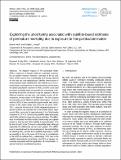Exploring the uncertainty associated with satellite-based estimates of premature mortality due to exposure to fine particulate matter
Author(s)
Ford, Bonne; Heald, Colette L.
Downloadacp-16-3499-2016.pdf (2.283Mb)
PUBLISHER_CC
Publisher with Creative Commons License
Creative Commons Attribution
Terms of use
Metadata
Show full item recordAbstract
he negative impacts of fine particulate matter (PM[subscript 2.5]) exposure on human health are a primary motivator for air quality research. However, estimates of the air pollution health burden vary considerably and strongly depend on the data sets and methodology. Satellite observations of aerosol optical depth (AOD) have been widely used to overcome limited coverage from surface monitoring and to assess the global population exposure to PM[subscript 2.5] and the associated premature mortality. Here we quantify the uncertainty in determining the burden of disease using this approach, discuss different methods and data sets, and explain sources of discrepancies among values in the literature. For this purpose we primarily use the MODIS satellite observations in concert with the GEOS-Chem chemical transport model. We contrast results in the United States and China for the years 2004–2011. Using the Burnett et al. (2014) integrated exposure response function, we estimate that in the United States, exposure to PM[subscript 2.5] accounts for approximately 2 % of total deaths compared to 14 % in China (using satellite-based exposure), which falls within the range of previous estimates. The difference in estimated mortality burden based solely on a global model vs. that derived from satellite is approximately 14 % for the US and 2 % for China on a nationwide basis, although regionally the differences can be much greater. This difference is overshadowed by the uncertainty in the methodology for deriving PM[subscript 2.5] burden from satellite observations, which we quantify to be on the order of 20 % due to uncertainties in the AOD-to-surface-PM[subscript 2.5] relationship, 10 % due to the satellite observational uncertainty, and 30 % or greater uncertainty associated with the application of concentration response functions to estimated exposure.
Date issued
2016-03Department
Massachusetts Institute of Technology. Department of Civil and Environmental Engineering; Massachusetts Institute of Technology. Department of Earth, Atmospheric, and Planetary SciencesJournal
Atmospheric Chemistry and Physics
Publisher
Copernicus Publications
Citation
Ford, Bonne, and Colette L. Heald. “Exploring the Uncertainty Associated with Satellite-Based Estimates of Premature Mortality Due to Exposure to Fine Particulate Matter.” Atmospheric Chemistry and Physics 16, 5 (March 2016): 3499–3523 © 2016 The Authors
Version: Final published version
ISSN
1680-7324
1680-7316